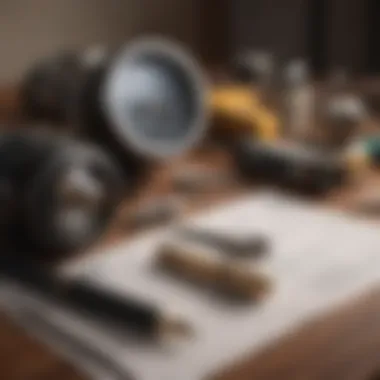FHA Loan Checklist: Mastering Home Inspection Success


Intro
Navigating the home buying process, particularly with an FHA loan, can be daunting. This article explores various inspection criteria that potential homeowners should understand. The FHA loan program is unique in its provisions designed to assist first-time buyers and low-income applicants. However, adhering to FHA's checklist regarding home inspection is crucial for a successful loan application. Here you will find a comprehensive guide that explores essential standards and sheds light on the home inspection process.
Prologue to FHA Loans
FHA loans have gained considerable attention in the home financing arena. Understanding these loans is essential for potential buyers as well as real estate professionals. They serve as a gateway for many individuals and families aiming to achieve homeownership, especially those who may find traditional loans inaccessible due to strict credit requirements or high down payments.
Understanding FHA Loans
The Federal Housing Administration (FHA) provides mortgage insurance on loans made by approved lenders. These loans are designed with specific characteristics to promote access to affordable home financing. One key trait of FHA loans is their lower down payment requirements. Homebuyers can often secure a loan with as little as 3.5% down. This encourages many to pursue homeownership who might otherwise remain tenants.
Additionally, FHA loans accept a wide range of credit scores. Borrowers with credit scores as low as 580 may qualify for the lowest down payment. Those with scores between 500 and 579 still have options but need a larger down payment of 10%. This flexibility increases the pool of eligible applicants.
There are also limits regarding how much you can borrow with an FHA loan, influenced by location and economic conditions. However, even with these limits, many find FHA loans to be advantageous compared to other lending products.
Importance of FHA Loans in Home Financing
FHA loans play a critical role in facilitating home ownership amongst various demographic groups. Firstly, they support low to moderate-income buyers. Families, young professionals, and students often benefit from the guarantees created by the FHA, allowing them the opportunity to realize their embers.
A recent study highlighted that first-time homebuyers make up a significant percentage of FHA loan applications. This statistic underscores these loans’ importance in easing the transition into home rentals.
Moreover, FHA loans contribute positively to the general economy. Increased home ownership translates to improved neighborhood stability, rising property values, and ticketing prospects for local governments. With access to affordable mortgages, communities can grow and enhance their economic capacities.
The Role of Home Inspections
Home inspections play a crucial part in the FHA loan process, ensuring that a property meets specific standards before securing financing. These inspections are not merely a formality; they serve to protect both the buyer and the lender by identifying potential issues that could affect the value or livability of the home. A thorough home inspection provides buyers with a clearer picture of what to expect from their new property, enabling informed decisions from the outset.
Purpose of Home Inspections
The primary purpose of home inspections is to provide a comprehensive assessment of a property’s condition. Inspection reports are guides that detail structural, functional, and safety-related components. They offer a look at the roof, foundation, and major systems like heating and plumbing. Buyers may find it overwhelming, but recognizing that this inspection can uncover hidden issues is vital.
Key purposes include:
- Safety Assurance: Assessing the safety of systems and structures minimizes risks to the future residents, promoting a safer choice for homeownership.
- Investment Protection: Identifying issues early can save massive costs later. If significant repairs are needed, buyers can negotiate with sellers or withdraw their bid.
- Compliance Knowledge: Understanding what needs to be fixed aids in future compliance with FHA regulations, facilitating successful loan approval.
FHA Inspection Requirements
FHA loans come with specific inspection requirements that serve the dual purpose of safeguarding homebuyers and upholding property values. Unlike standard purchasing agreements, FHA regulations dictate what must be inspected and approved before a loan is issued. This focus is essential in a climate where maintaining affordable housing stock is a growing concern.
To summarize:
- Structural Soundness: Homes must be structurally sound without any major defects.
- Safety Standards: Safety features like railings and smoke detectors must be in place and functioning.
- Durable Materials: Components of the property, including roofing and siding, must be in good condition.
FHA Loan Inspection Checklist Overview
An FHA loan inspection checklist serves an important role in ensuring that homes meet specific standards set by the Federal Housing Administration. This checklist does not simply aid in the inspection process; it helps homebuyers understand the expectations surrounding any property they consider purchasing with federal backing. Solid preparatory knowledge of the FHA inspection requirements can mitigate hurdles during the home-buying process, especially for first-time homeowners.
The checklist guides potential buyers through various elements which are crucial for passing inspection, greatly reducing anxiety over last-minute surprises. Note that failure to adhere to these listings can lead to financing denials, which can be devastating for a buyer looking to secure their new home. Thus, being prepared with a comprehensive understanding of the FHA inspection checklist not only aids individuals seeking housing but also ensures compliance with financial aid following these guidelines.


Key Components of the Inspection Checklist
The key components of the FHA inspection checklist are centered around safety, security, and soundness standards. Each area targeted by the checklist adheres to FHA minimum property requirements designed to protect buyers and their investments.
- Safety Hazards: Inspectors will actively look for safety hazards outlined in the checklist, such as unprotected staircases, lead paint risks, and exposed wires.
- Structural Focus: Building structure assessment will encompass items like suitable foundations, rotten wood, or decaying roofs that can compromise longevity of the home.
- Systems Integrity: Electrical systems, plumbing and HVAC should be checked to ensure they operate effectively, as these are essential for comfort.
- Pest and Infestation Concerns: The checklist addresses potential environmental risk from pests or termites which can swiftly degrade structural integrity.
This broad focus guarantees buyers are moving into homes that require minimal intervention right after purchase, significantly lessening future financial strain.
Required Documentation for Inspections
Documentation serves as the backbone of any well-executed FHA inspection. The required materials help facilitate transparency to concerned parties and soothe apprehension throughout the inspection process.
Documents often required include:
- Sales Contract: Clearly outline transaction details and expectations between the buyer and seller.
- Inspection Checklist: Copies of the examination criteria and findings conducted per FHA mandates.
- Repair Estimates: Necessary when issues arise, these show potential buyers the costs involved in addressing identified problems.
- Disclosures: Sellers need to present necessary disclosures relating to past issues, particularly with pests, mold, or any damage to walls and roofing.
It is imperative to realize that compiling all appropriate documentation beforehand enhances discussion and eventual agreement on repairs and required follow-ups. Emphasizing these points not only makes negotiations smoother, but also helps finalize the loan while ensuring all potential problems are duly resolved for a successful purchase.
Clear understanding and preparation prior the inspection minimizes potential post-purchase regrets.
Property Condition Standards
Understanding Property Condition Standards is crucial for anyone navigating the FHA loan process. Adhering to these standards not only affects eligibility for financing but also ensures that the home is safe and suitable for habitation. These standards set the foundation for the thorough evaluation your property undergoes during an inspection, making them key factors in closing a successful housing deal. Particularly, as potential homeowners, familiarizing yourself with these minimum requirements strengthens your negotiating position and leads to more informed purchasing decisions.
Property Condition Standards are designed to guarantee that a home meets essential quality and safety benchmarks that protect occupants. The FHA emphasizes structural integrity, health aspects, sanitation, and operational functionality of home features like plumbing or electric systems. Nonconforming properties can cause delays in loan approvals, necessitating costly repairs prior to completing any financing arrangements.
Minimum Property Requirements
The FHA specifies Minimum Property Requirements, also referred to as MPRs, which dictate the fundamental aspects that eligible homes must comply with.
These standards ensure that homes include:
- Safe water supply and sanitation: For health and quality of life.
- No hazards or imminent dangers: Harmful elements such as mold or outdated wiring must be addressed.
- Stable foundation: Key component for structural safety which fewer complaints future rom infastructure anomalies.
By visually verifying these aspects, buyers gain lasting satisfaction in their home investments. Even minute questions about these requirements should ideally be discussed with industry experts.
Health and Safety Standards
Beyond mere aesthetics, Health and Safety Standards stretch across several important dimensions that must be met before an FHA-insured loan can be approved. These stipulations ensure that all aspects within the home do not pose any immediate health risks to the potential victim of harmful hazards simultaneously improve wellness areas navigated related to home upkeep. Consider the following elements:
- Lead-based paint regulationp: Any property built prior to 1978 needs thorough assessment; children are especially vulnerable.
- Proper ventilation: Vital for preventing mold and affecting indoor air quality and retention of heat diminishing utility saving difficulties.
- Secured entry points: Doors or windows lacking proper locking mechanisms can easily become vulnerable against break-ins.
Achieving adherence to Health and Safety Standards generally signifies a healthier living space.
Understanding and addressing these conditions ensures that a property is safe enough for current inhabitants without undermining future inhabitants sustainable livability and comfort needs in first resident format. Financing processes are more likely to clear smoothly and enable successful loan acquisition plans confidently.
Common Issues Identified During Inspections
The inspection phase is an essential step in securing an FHA loan. Understanding common issues is vital for potential homebuyers. If problems arise, they can delay loan approval or increase costs. Recognizing these issues will help in better negotiation and ensure that properties meet logistical and structural expectations.
Structural Deficiencies


Structural integrity is the backbone of any home. Deficiencies in this area are especially concerning as they can compromise safety and longevity. Common structural issues include the following:
- Foundation Cracks: Small cracks may seem minor, but larger or expanding gaps can indicate serious issues. It is critical to address foundation integrity early in the inspection process.
- Framing Problems: Inspectors look for any irregularities in the framing. Support beams and load-bearing walls should be secure and correctly positioned. Any misalignment can lead to greater concerns down the line.
- Settlement Issues: A settling home may display uneven floors or gaps in trim. Some elapsed exchanges across seasons can normal, but observe closely for excessive changes.
Identifying structural issues prompts necessary actions. Depending on the severity of the damages, a buyer may decide against the property or negotiate repair commitments.
Electrical and Plumbing Concerns
Safety is at stake with adequate electrical and plumbing systems. These two categories largely affect function and livability. Common concerns are:
- Outdated Wiring: Many properties date back several decades; older wiring may not meet modern safety codes. Inspectors examine outlets, circuit breakers, and overall capacity.
- Water Leaks: Water damage can lead to severe issues like mold growth or structural weakening. A thorough plumbing check will catch leaks and faulty pipes. Notice the condition of water heaters and drainage systems as well, and does it align with expected standards.
- Inadequate Circuits: Modern households often require more power than older homes were designed for. An inspector will note how many circuits are present and their adequacy for current needs.
Understanding these problems and consulting with professionals is crucial for addressing repairs. Engaging qualified technicians ensures safety and compliance with FHA standards.
Roof and Exterior Condition
The exterior condition, similar to structural concerns, impacts both safety and efficiency. Attention should be paid to these aspects:
- Roof Aging: Sellers and buyers must consider the roof’s age. It typically requires replacing every 15 to 30 years, depending on materials. An inspector assesses the type of materials used, their condition, and existing leaks, if any.
- Siding Damage: Cracks or warping in the siding might signal deeper issues. Effective siding provides insulation and shields against elements. Address any visible issues to avoid further damage or energy loss.
- Window Integrity: Inspect windows for functionality and seal integrity. Subpar installations or cracks can lead to energy inefficiency, impacting overall home comfort.
Being attentive to these aspects during the inspection led early to risk management. Appropriate measures can save costs and time later on, allowing buyers to proactively engage with their choice of residences.
Always keep in mind that understanding what to look for, alongside expert evaluation, enhances the overall FHA loan experience. For more comprehensive insights on home inspections, feel free to read more on Wikipedia or Britannica.
Preparing for the FHA Inspection
Preparing for an FHA inspection is a critical step for homeowners and potential buyers. It serves as a bridge between securing a loan and obtaining a satisfactory property condition report. Knowing how to prepare is essential for making the process smoother, reducing the chance of disappointment or delays. An adequately conducted inspection will help ensure compliance with FHA regulations, ultimately making your home buying journey more successful.
When preparing for the inspection, you should consider several key factors that influence both the inspection outcome and the FHA approval process. Early preparation fosters an understanding of what the inspector looks for during a review, which can alleviate stress and lead to better results.
Tips for Homeowners
Homeowners have an important role in the FHA inspection process. By taking steps to prepare their property, they can minimize issues and enhance the likelihood of passing the inspection. Here are some tips to assist homeowners in this preparation phase:
- Conduct a Pre-Inspection Review: Examine your home meticulously. Check for visible defects or issues, such as peeling paint, roof concerns, or faulty railing.
- Make Necessary Repairs: Address any identified problems before the inspector arrives. This might include touching up paint or fixing an overflowing toilet.
- Clean and Declutter: A clean and organized home provides a better impression. It allows the inspector to assess the property without distractions.
- Consult Local Codes: Review local building codes in your area. This may help identify any potential compliance issues before they arise.
- Gather Important Documents: Helpful documents include warranties for appliances and previous repair receipts. This shows your upkeep commitment.
By embracing these tips, homeowners can approach the inspection process more confidently and intelligently.
Choosing the Right Inspector
Selecting the right inspector is another fundamental part of preparing for an FHA inspection. Having an experienced and knowledgeable inspector can significantly influence the outcome of the process. Here are algunos elements to consider while choosing an inspector:
- FHA Knowledge: Ensure that the inspector has thorough knowledge of FHA requirements. This will enable them to evaluate the property according to industry standards.
- Credentials and Experience: Look into the inspector's qualifications. Experience counts; thus, choosing someone with extensive home inspection experience can be advantageous.
- Reviews and Recommendations: Seek out recommendations from friends or real estate professionals. It's also beneficial to read reviews on websites like Reddit or Facebook.
- Sample Reports: Ask potential inspectors for examples of past inspection reports. This will help determine their level of detail and thoroughness.
- Cost Considerations: Understand the fees involved with the inspection. While it is important to find a qualified professional, being mindful of your budget is also necessary.
A thoughtful approach to choosing the right inspector can make a significant difference in ensuring that your home meets FHA standards.
After the Inspection: Next Steps
After completing an FHA inspection, understanding the subsequent course of action is vital for homebuyers. This phase directly influences the trajectory of securing an FHA loan and ensuring the closing process goes smoothly. Buyers should approach the inspection results systematically and thoughtfully. A clear plan of action will benefit negotiations with sellers and pave the way for a successful homeownership journey.
Interpreting Inspection Results


Upon receiving the inspection report, it's crucial to review the findings thoroughly. Each identified concern should be assessed in terms of severity and category. Important factors to consider include:
- Safety and Habitability: Some issues may pose immediate safety risks, necessitating urgent resolution. Examples include structural deficiencies or electrical hazards.
- Reasonable Foresight: A buyer must determine if an issue is likely to be long-term or if it could lead to larger problems down the road.
- Relevance to FHA Standards: Specifically identify if issues directly conflict with FHA compliance standards. In this context, an inspector will check adherence to health and safety codes.
Buyers are encouraged to bring in qualified contractors to evaluate these findings. Doing this will provide insights into repair costs and timelines, making it easier to communicate with the seller.
Addressing Repairs and Compliance
Once buyers understand the concerns, the next step focuses on whether the repairs are required by the seller prior to closing or are they simply needs to do in future. Several considerations arise during this stage:
- Negotiation with the Seller: It's important to engage in constructive communication regarding any issues raised in the inspection. Buyers may request that the seller either complete necessary repairs or offer a credit to offset repair expenses.
- Compliance with FHA Guidelines: A seller must complete specific repairs to comply with FHA lending guidelines. Noncompliance could stall or nullify the potential for loan approval.
- Documentation of Repair Requests: Buyers should document all discussions and repair requests. Clear communication forms a fail-safe record, which may be beneficial should complications arise during negotiations or in the lending process.
To navigate this process smoothly, consider developing a prioritized list of repairs. A structured ,logical way of addressing repair requests can facilitate discussions.
After difficult conversations, maintaining rapport with your client helps in managing expectations and preserving the essence of the deal.
Following these steps ensures a clear pathway from inspection to closing and mitigates surprises that arise from unforeseen compliance issues.
Frequently Asked Questions about FHA Inspections
FHA inspections can raise a lot of questions, especially for first-time homebuyers and those unfamiliar with the FHA loan process. Understanding these questions and their answers is crucial. Not only does it provides clarity, but it also helps in the overall management of expectations throughout the financing journey. A well-informed buyer is better positioned to navigate potential challenges.
The following subsections address some common yet crucial inquiries regarding FHA inspections, contributing to the broader conversation around FHA loans and their intricacies.
Who is Responsible for Inspection Costs?
The responsibility for covering the inspection costs usually falls on the buyer. It is an essential part of the home buying process that should be budgeted for early. In some cases, it could be negotiated as part of the closing costs or through seller concessions, but this depends on mutual agreement between the buyer and the seller.
- Buyer's Responsibility: Usually, the buyer pays for the inspection upfront. This is often viewed as a worthwhile investment for understanding the property’s condition.
- Negotiate Costs: In a competitive market, buyers can ask sellers to contribute to these costs. This could be part of the sales agreement.
- Cost Varies: The inspection cost will range depending on factors such as property size and location.
An FHA inspection can alert the buyer to issues that may turn into costly repairs after purchase, making it a critical step in the home buying process.
What Happens if Issues are Found?
Finding issues during an FHA inspection does not necessarily derail the home-buying process. However, it does present a set of challenges that require thoughtful consideration.
- Negotiation: If significant concerns arise, buyers are usually given the chance to negotiate repairs. This could involve either requesting that the seller addresses the issues prior to closing or obtaining a price reduction to cover future repairs.
- FHA Standards: The FHA has specific property standards. If issues violate these standards, it may complicate the approval process, with necessary corrections needed before funding.
- Documentation: It is imperative to document all findings from the inspection. Buyers can work closely with their real estate agent to ensure all concerns are properly addressed in writing.
Epilogue
In the journey of securing an FHA loan, the conclusion serves to emphasize the critical points discussed throughout the article. Understanding the comprehensive checklist, including specific inspection requirements and potential issues that might arise, significantly aids both buyers and real estate professionals. A thorough knowledge of what to prepare for prior to the inspection is not only useful but vital.
Focusing on compliance can or must simplify the purchasing process. It acts as a guideline that delineates steps to undertake, such as coordinating with the right inspector and being aware of health standards. The homeowner who prioritizes these factors opening can streamline their experience pursuing FHA loans.
Summarizing Key Takeaways
The key takeaways from this article underline the significance of carefully conducting home inspections before an FHA loan's approval. Some important takeaways include:
- Preparation is key: Always start getting ready for the FHA inspection ahead of time. This includes selecting a qualified inspector.
- Know the standards: Familiarize yourself with the specific FHA regulations and requirements. Noncompliance may lead to delays.
- Address concerns immediately: If the inspection identifies any issues, prompt attention ensures compliance and quicker loan processing.
- Understand inspection costs: Clarifying who bears the financial responsibility for inspections can avoid confusion. Both parties should communicate clearly.
The Importance of Compliance for FHA Loans
Compliance holds immense significance regarding FHA loans. It safeguards not only the lending institution but also protects the interests of prospective homeowners. The core facets of compliance involve following both property condition standards and federal regulations associated with the FHA program.
Following through on compliance assures that the property is both safe and valuable, which in turn helps affirm lender expectations. Similarly, it mitigates the risk of future repair issues. Meeting the FHA criteria lays a robust groundwork for the buyer, allowing access to housing opportunities that promote long-term stability.
In essence, compliance demonstrates commitment. It shows the dedication of buyers to uphold higher standards in homeownership. Ultimately, this intertwines with the goals of FHA home financing, creating a smoother pathway for all involved.







